
Santa Maria Gloriosa dei Frari (Basilica di Santa Maria Gloriosa dei Frari) is a church (cathedral) in Venice, which has the status of a minor basilica and is dedicated to the Assumption of the Blessed Virgin Mary.
The Basilica is often called simply Frari (Basilica dei Frari).
The Basilica dei Frari is one of the most important and largest in Venice. It has mostly retained its Venetian Gothic look, and its interior is notable for the majestic monuments of outstanding Venetians, including paintings and as the resting place of Titian, Antonio Canova and a number of doges.
Today it is also a museum and a place where concerts are regularly held.
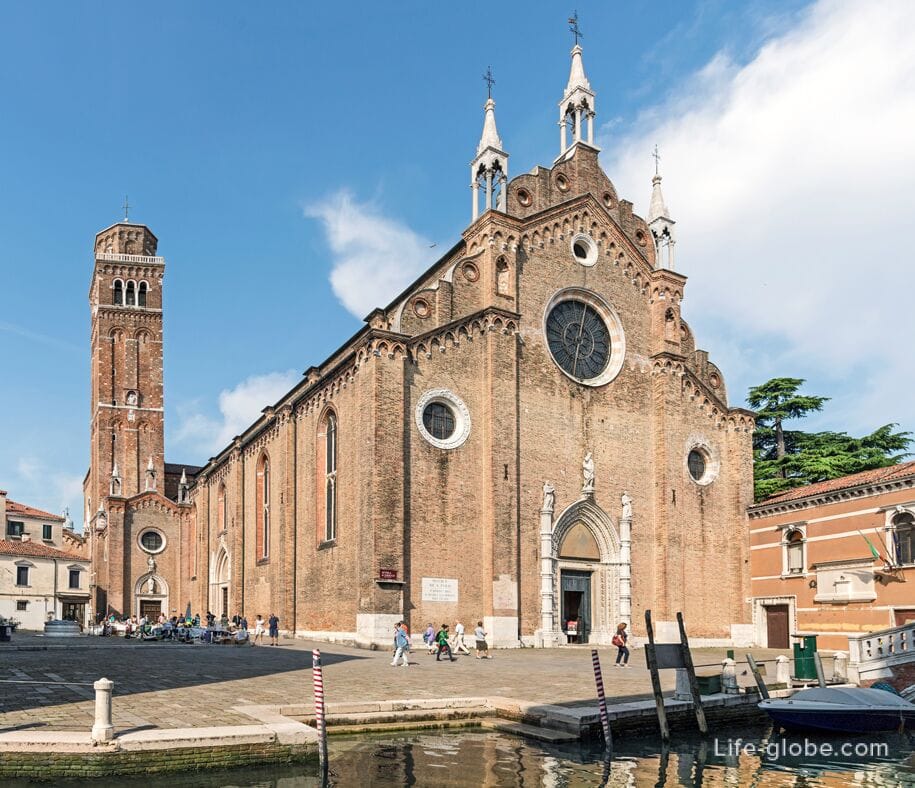
The basilica is located in the historical center of Venice, in the San Polo district (sestiere di San Polo) on the Campo dei Frari, near the Frari Canal (Rio dei Frari), across which the Frari Bridge of the same name (Ponte dei Frari) is spanned near the basilica.
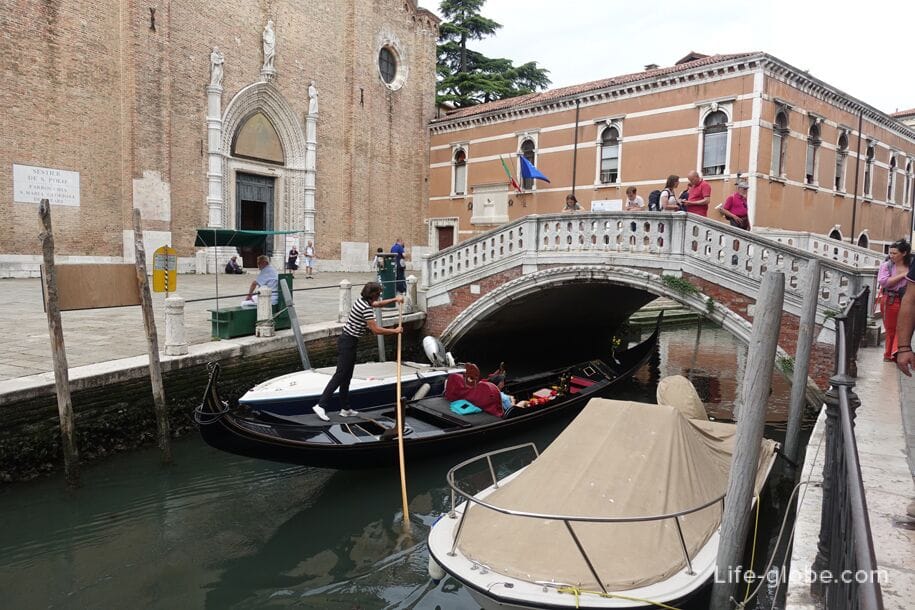
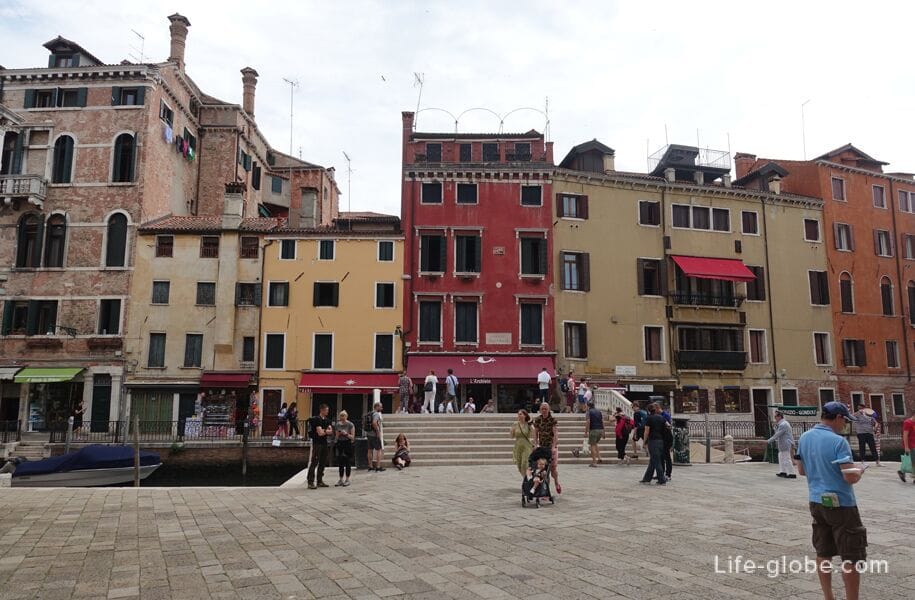
The history of the birth of the church began in 1231, when, under Doge Jacopo Tiepolo, the city donated land on this site to the Franciscan order of the younger brothers for the foundation of a monastery and a church.
The current church is the third on this earth. The first two were rebuilt because they became too small too quickly to accommodate the parishioners. Construction began in 1330. The work was started by architect Jacopo Selega, but completed by his son Pierre Paolo. The bell tower of the basilica, which is the second tallest in Venice after the bell tower of San Marco, was completed in 1396. Under the patronage of the Doge Giovanni Corner, the Chapel of San Marco was created in 1420. In 1432-1434, Bishop Pietro Miani of Vicenza ordered the construction of the chapel of San Pietro next to the bell tower in order to be buried there after his death. The main altar of the church was consecrated in 1469. In 1478, the Pesaro family commissioned a sacristy in the apse of the shrine as a noble family chapel and tomb. On May 27, 1492, the church was consecrated in the name of Santa Maria Gloriosa. However, the cornice of the facade was crowned with three statues only in 1516, these are the works of Lorenzo Breno.
Today, this basilica is one of the main attractions of Venice. It has a Venetian Gothic look, some sculptural and architectural decorations, as well as a high tower-bell tower in the Romanesque style, which reaches a height of 70 meters.
A small cloister (monastery courtyard) adjoins the basilica.
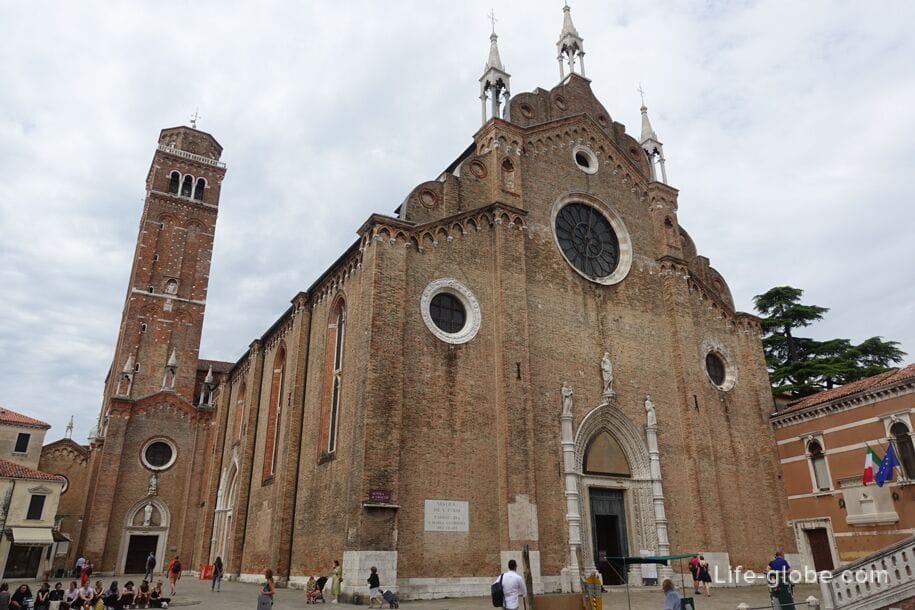
The facade of the basilica is divided into three parts by two columns, which at the top are reduced to simple late Gothic pilasters.
The portal is highlighted by a pointed arch, which at the very top is decorated with a sculpture of the Risen Christ by Alessandro Vittoria (1581); to the left of Christ on the column is the Virgin and Child, and to the right is St. Francis, these are statues by the sculptor Bartolomeo Bon (shortly after 1430).
In the lunette of the portal there is an obscure fresco by Gaetano Dompini (18th century) depicting the Immaculate Conception among the angels. Above there are three round rosette windows made of white Istrian stone. The one on the left, white, is decorated with a Venetian lion and a Florentine lily in a carved frame to indicate the inner chapel of the Florentines in the basilica; on the right, slightly smaller and two-colored, there is a sculptural figure of St. Anthony, indicating that the chapel of the same name is located inside.
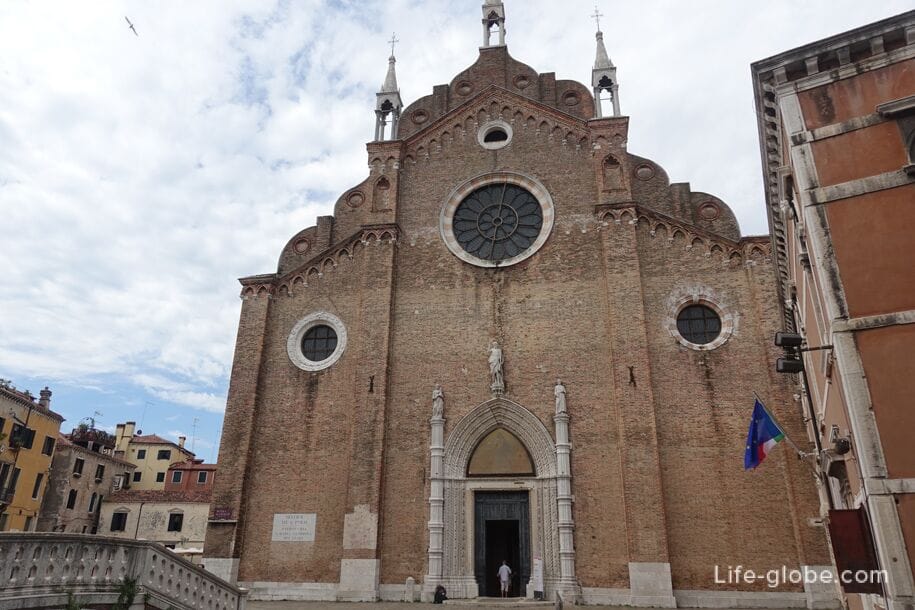
The Romanesque bell tower was started by the Venetian Jacopo Celega in 1361 and completed by his son Pierre Paolo in 1396. The bell tower has arched windows, sculptural decorations and a loggia in the upper part. The bell tower is made almost entirely of terracotta, with the exception of white stones dividing the bell tower into three parts, as well as columns and arches.
In 1490, the bell tower was damaged by a lightning strike, and then modified in the preserved end projection: instead of the crowning bell tower of the lead pyramid, similar to the pyramid of the bell tower of San Marco, the current polygonal drum crown was built.
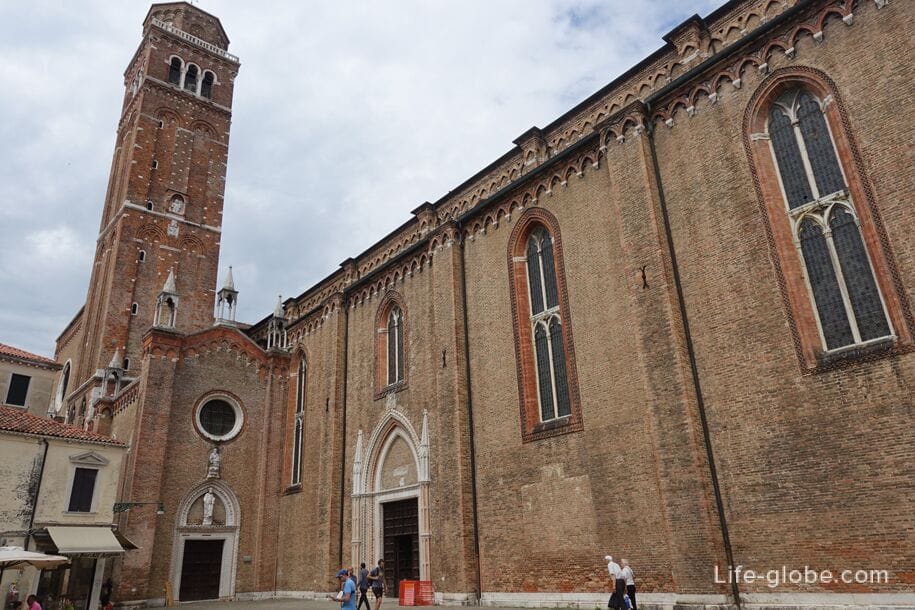
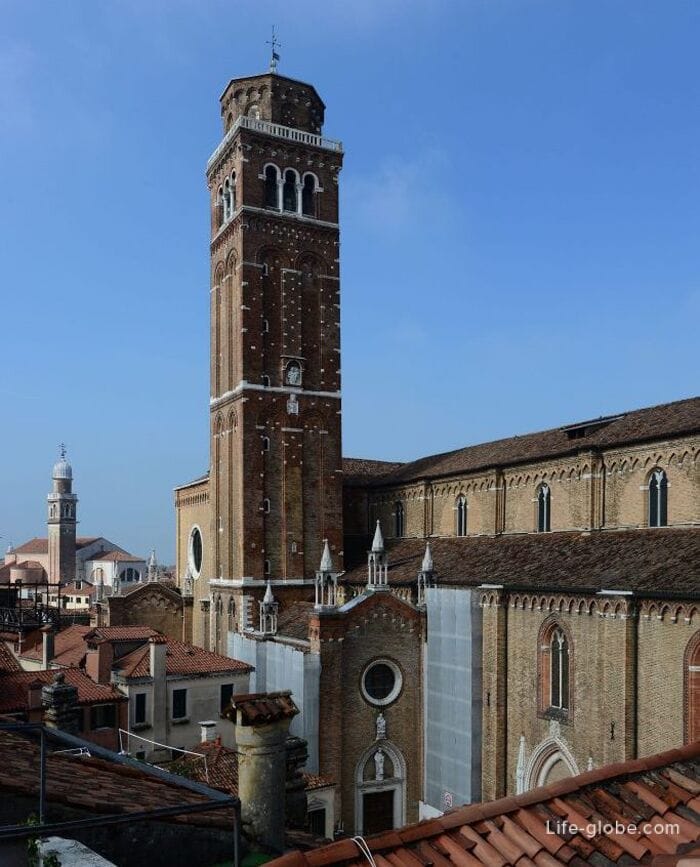
The length of the basilica is 102 meters, and its width is 32 meters.
The basilica is made in the form of a Latin cross, has three naves with a transept, separated by large columns.
Six apsidal chapels with a polygonal plan extend over the entire transept, and the aisles are divided from the center by six pairs of large pillars topped with capitals, with two orders with hooked leaves, on which the cross arches are located. The fifth pair, at the entrance to the choir, has three-bladed pylons. In the central apse, round columns have been replaced by elegant polystyle columns.
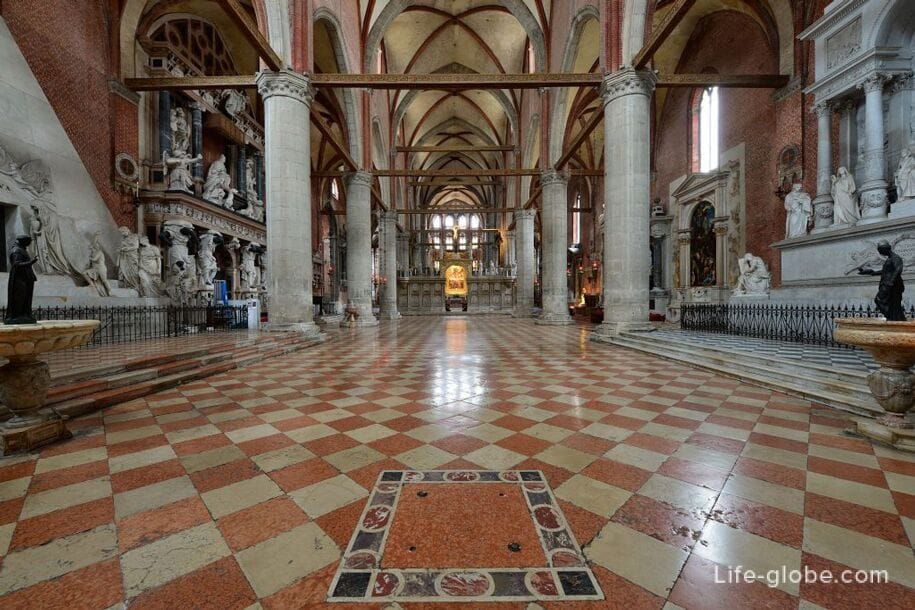
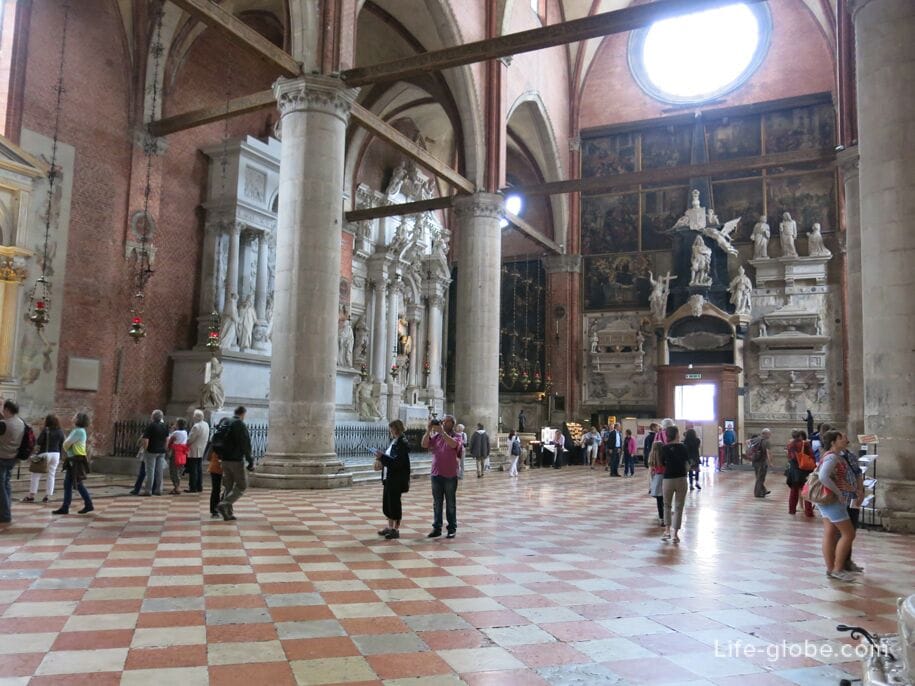
The main altar of the basilica consists of two columns connected by an architrave, above which are sculptures by Lorenzo Breno: in the center is a sculpture of the risen Christ, to His left is a statue of St. Francis of Assisi, to the right is St. Anthony (1516).
Above the altar, in the apse of the presbytery, dominates the most important masterpiece of the Basilica - the magnificent painting "The Ascension of the Virgin Mary", or "Assunta" by Titian, which was commissioned by the artist Father Germano da Casale, and presented on May 20, 1518. The size of the painting is 6.90 by 3.60 meters. It is painted in oil on a wooden panel made up of several boards.
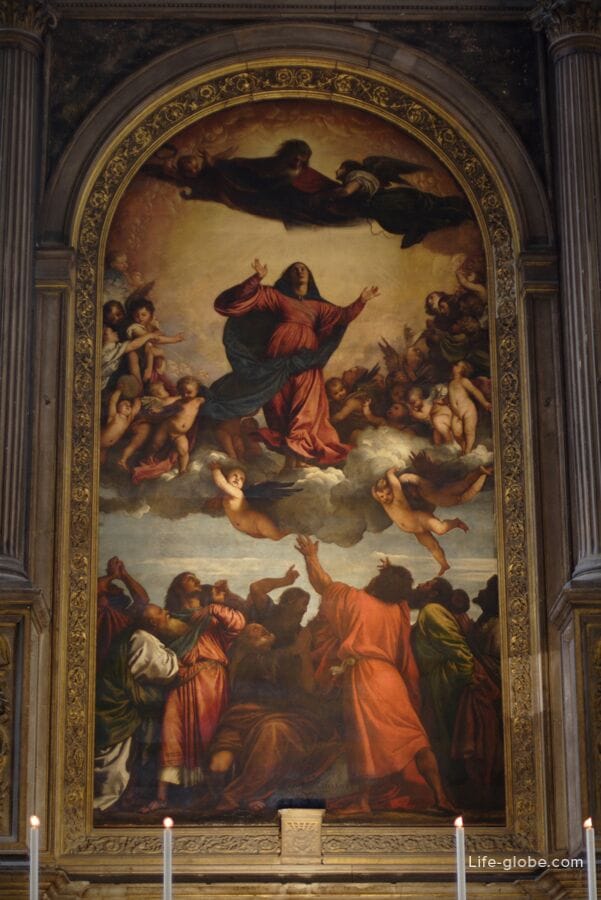
On the left wall of the presbytery is the mausoleum of Doge Niccolo Trona by Antonio Rizzo from Verona, and on the right is the mausoleum of Doge Francesco Foscari, the work of Florentine artist Nicolo di Giovanni. The urn in which the doge rests is supported by four small shelves decorated with images of three theological virtues: Faith, Hope and Charity, by Antonio Rizzo.



The choirs of the church amaze with their beauty and grandeur. They have retained their original location - in the central nave in front of the main altar.
The choirs were created in 1468 by Francesco and Marco Cozzi. The choirs are decorated with Italian carvings with relief sculptures of saints and geometric shapes.
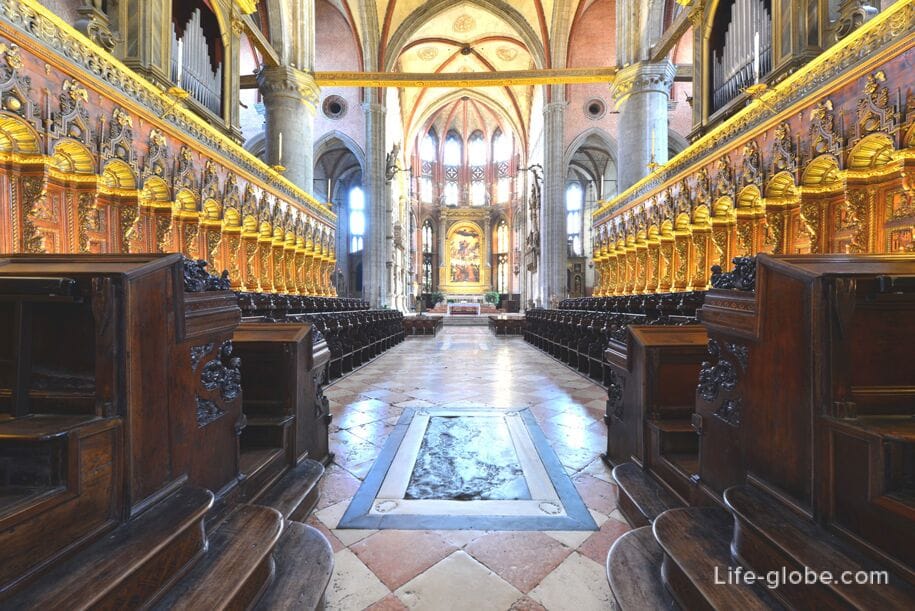
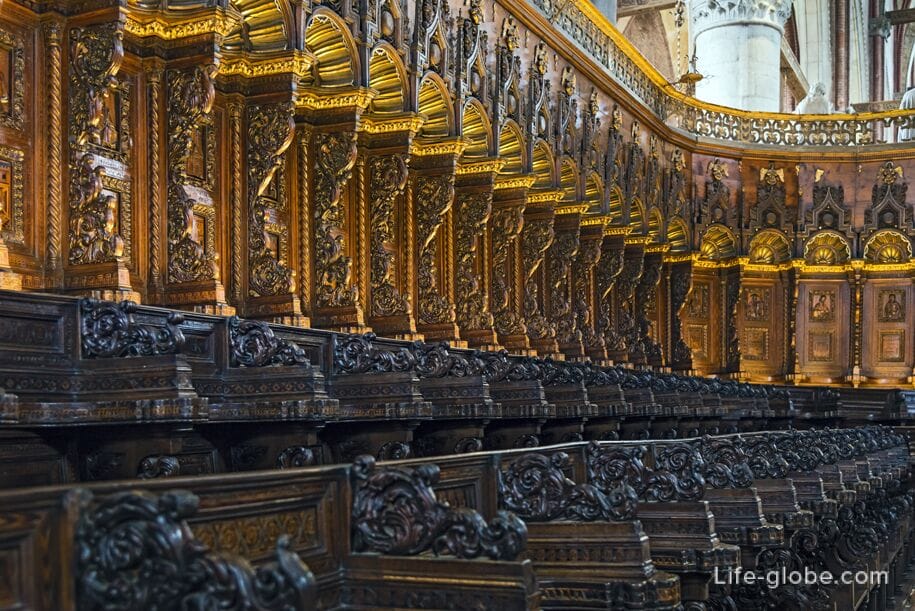
The choir stalls are surrounded in front by an elegant marble partition, created in 1475 in the Workshop of Pietro Lombardo.
The partition panel depicts relief busts emerging from bundles of leaves, patriarchs and prophets of the Old Testament. Above the wedding, raised in the center by an arch and with two pulpits on the sides, there are statues of the eight apostles, as well as San Antonio and San Francesco, attributed to Vittore Gambello, known as Camelio (circa 1460-1537). The Virgin and Saint John by the same sculptor frame an impressive central Crucifix above the arch, the work of an unknown Venetian carver (1474). The four Teachers of the Church and the busts of San Bernardino and San Lodovico d'angio, carved on the inside of the two graceful columns supporting the arch, are a valuable work of Pietro Lombardo.
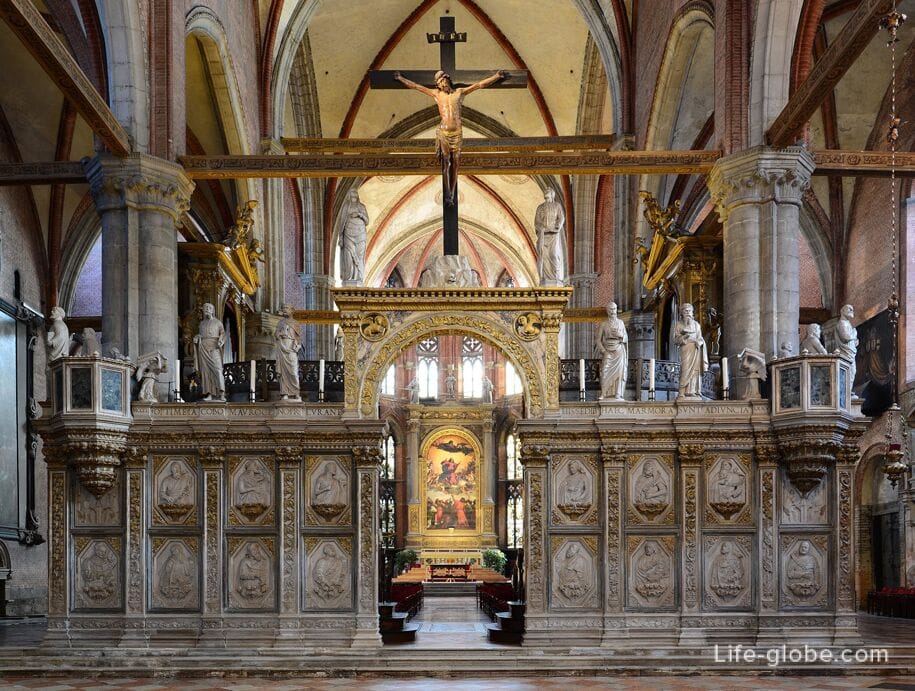

Two chapels stand out in the right apse:
The Chapel of San Giovanni Battista (chapel of St. John the Baptist), which is also called the Florentine chapel, because it was given to the Florentine School, whose members commissioned Donatello to create a wooden statue depicting the saint to whom the chapel is dedicated.
The altarpiece, in the center of the only statue of Donatello in Venice
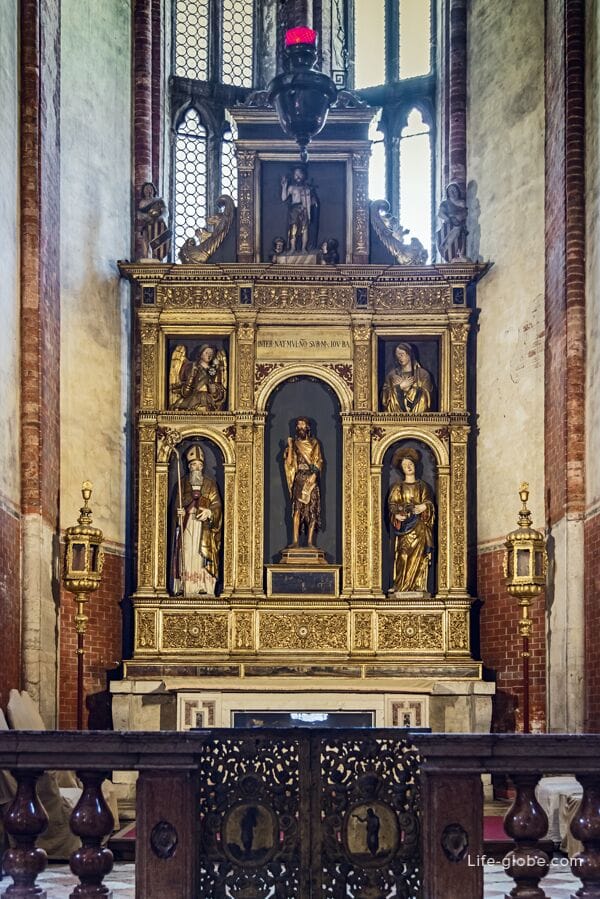
The Bernardo Chapel, which has as an altar a polyptych by Bartolomeo Vivarini, signed and dated 1487. This painting, which is still in its original frame, represents the Madonna and Child and Saints Peter, Paul, Andrew and Nicholas; at the top is a Pieta. On the right wall there is an urn of the early 15th century, Gothic art, designed to store the remains of Lorenzo and Girolamo Bernardo. Under the altar there is a statue with the relics of the blessed pagan da Matelik, a junior monk who died a martyr's death in Persia on September 5, 1340. His body was brought to Venice by Doge Marco Corner.
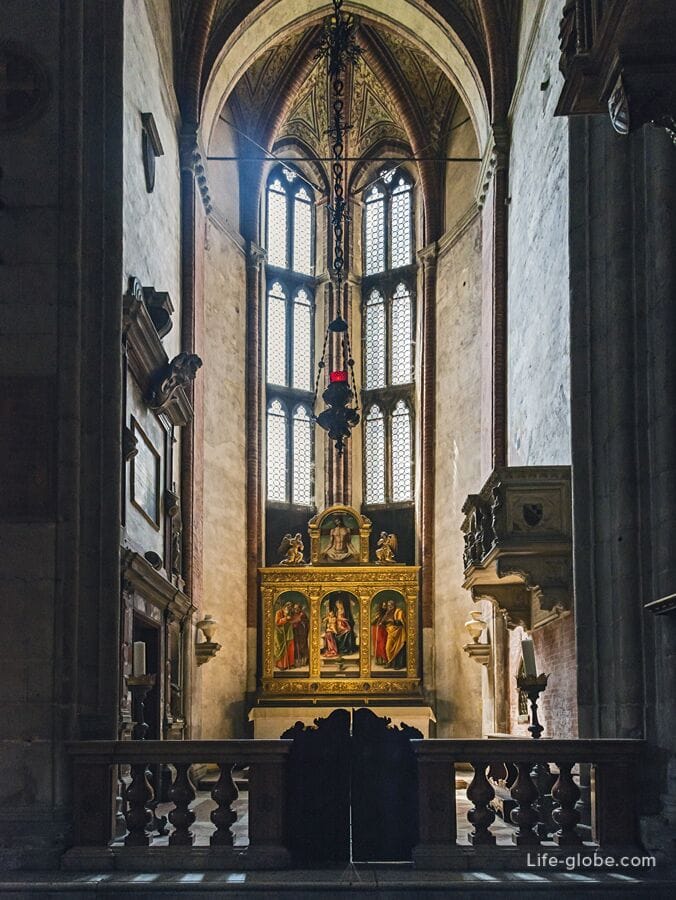
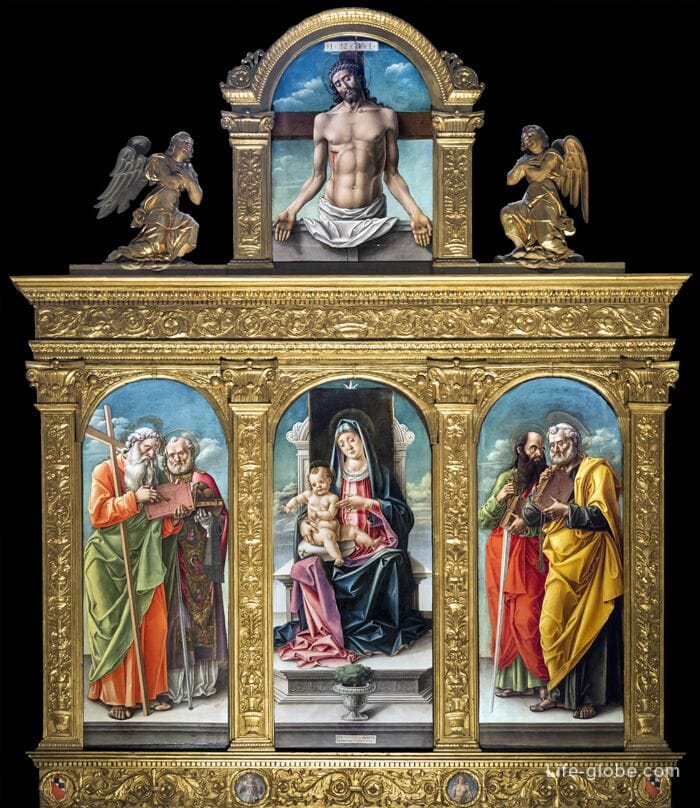
Next to the Bernardo chapel is a door leading to the sacristy, the modest original room of which was enlarged after it was transferred to the Pesaro family in 1478.
In the sacristy there is a remarkable tabernacle-a reliquary of Precious Blood by Bartolomeo Bellano and a workshop created to store a relic donated by Melchiorra Trevisan to the church in 1480. On the sides of the tabernacle are statues of John the Baptist by Tullio Lombardo and Francesco di Assisi by his brother Antonio.
On the altar there is an altarpiece with the Madonna enthroned with a Baby surrounded by Saints Nicolo, Pietro, Benedetto, Marco and two angel musicians, a triptych by Giovanni Bellini, signed and dated 1488. The work still has the original frame carved by Jacopo da Faenza.
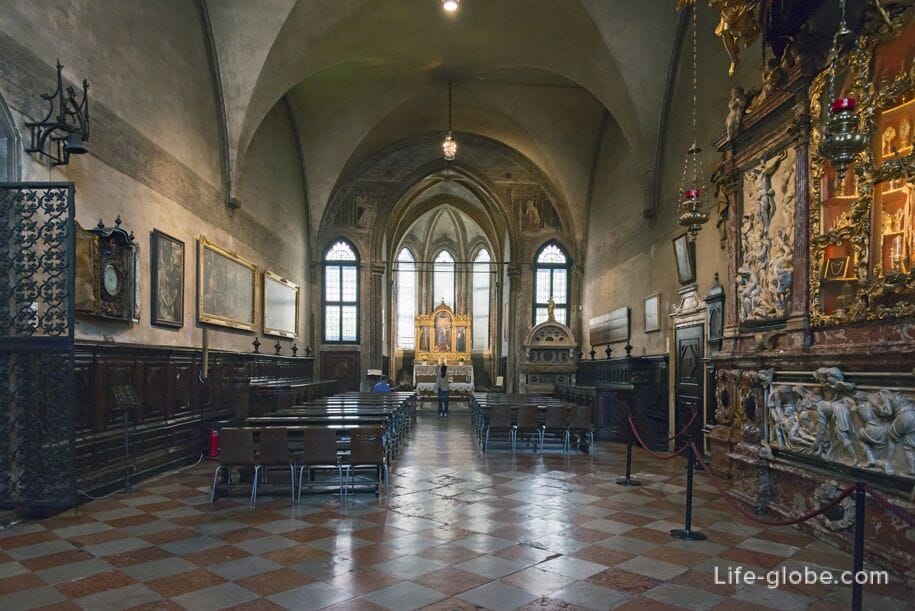


In the Chamber of the Head there is a monument to Doge Francesco Dandolo and a Chest on which there is a relief with the Assumption of the Virgin, which was once completely gilded. Above the casson, Francesco Dandolo and his wife represent the Madonna and Child of Saints Francis and Elizabeth, painted by Paolo Veneziano (1339).
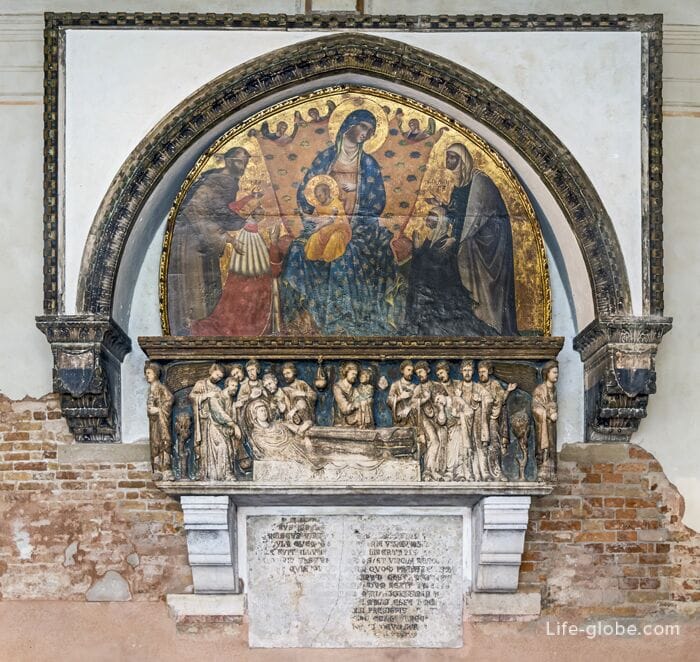
The left apse of the basilica:
the chapel of the Franciscan Saints, where on the altar there is an altarpiece by Bernardino Licinio from 1535 depicting the Madonna and Child enthroned among Saints Antonio, Ludovico da Tolosa, Francesco and Bonaventure;
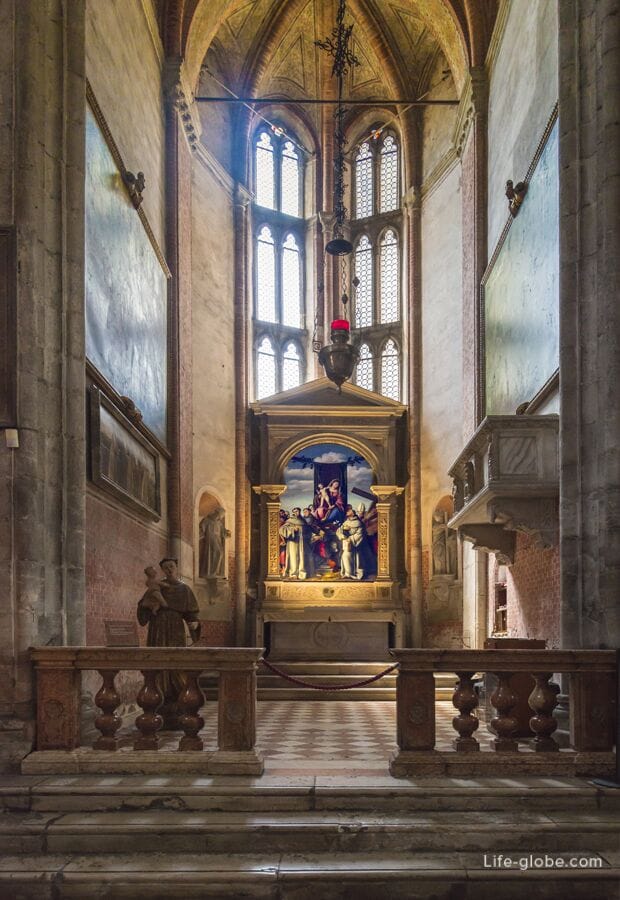
The Chapel of St. Michael (San Michele, also known as the Chapel of Trevisan), in which above the altar there is a wooden triptych with statues of Saints Antonio, Michele and Sebastiano, Venetian art of the fifteenth century. On the right wall there is a monument to the commander of the fleet Melchiorra Trevisan, who died in Kefalonia in 1500. The statue of the leader is attributed to Lorenzo Breno. On the left wall there is a picture of the Immaculate Conception surrounded by saints - a large canvas by Giuseppe Angeli;

Chapel of the Milanesi (Milanese), on the floor of which are the grave emblems of Franciscan monks of Lombard origin, as well as the tomb of Claudio Monteverdi, who died in Venice in 1643. On the right wall there is a painting by Tizianello, signed by Giovanni Contarini, in which Saint Ambrose expels the Arians, and on the left wall Sant'Ambrogio does not allow Emperor Theodosius to enter the church. The altar is dominated by the altarpiece of Alvise Vivarini, which depicts Saint Avmrosy on a throne between the angels-musicians and eight saints, at the top - the Coronation of the Virgin. The altarpiece, in connection with Vivarini's death, was completed by Marco Basaiti in 1503.

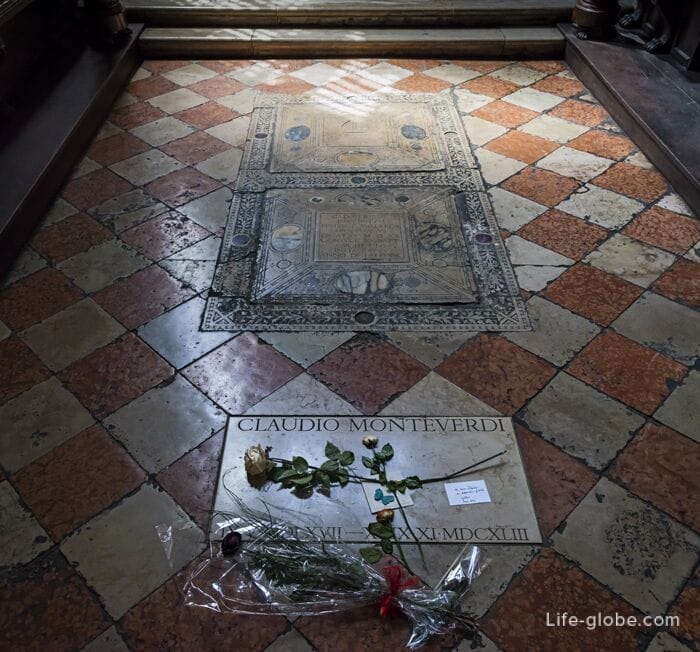
The last chapel on the left is the Chapel of San Marco (St. Mark's, also known as the corner chapel), which was added to the original building of the basilica in 1417 by order of Giovanni Corner in memory of Marco, an outstanding representative of a noble Venetian family.
The altar is topped with a triptych by Bartolomeo Vivarini, signed and dated 1474, and possibly partially executed with the help of a workshop. The triptych depicts Saint Mark enthroned between the angel musicians, Saints John the Baptist and Jerome on the left and Niccolo and Paolo on the right.

In the left aisle of the basilica is the remarkable chapel of San Pietro (Saint Peter), also known as the Emiliani Chapel in memory of Pietro Miani, Bishop of Vicenza, who built it in 1432 and where he was buried in 1464.
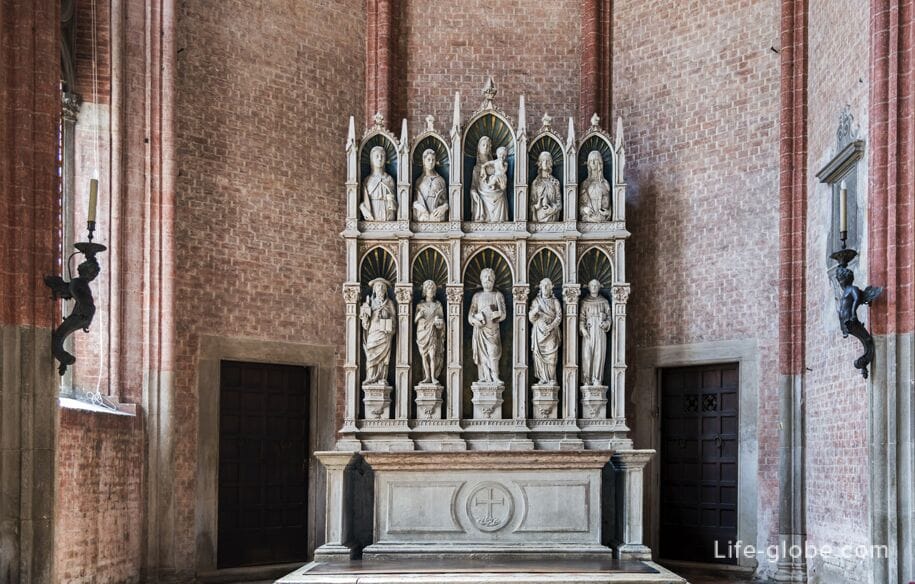
Near the chapel of San Pietro, the Pesaro Altar is striking - a painting by Titian, painted in oil on canvas and dating from 1519-1526.

The most striking asset of the left aisle of the basilica is the tombstone of Antonio Canova, an Italian sculptor and artist.
In 1794, Antonio Canova designed and built a model of the tombstone monument to Titian, but there were many difficulties in raising the funds necessary for its construction, so in 1822, the year of Canova's death, the monument was still at the design stage. Canova was buried in Possagno, his hometown. After that, the Academy of Fine Arts of Venice decided to build a monument to preserve the porphyry urn with the artist's heart; the work was executed by six students of Canova, from Carrara marble and according to the design and model that Canova prepared for Titian in 1794, and completed in 1827.
The monument has a cenotaph-pyramidal shape and is decorated with mythological characters. Above the three steps rises a pyramid with an open door leading to the alleged crypt. In front of the open door there is a sculptural procession: figures of women representing weeping sculpture, painting and architecture, followed by three little geniuses with lighted torches (art does not die!). On the left, at the base of the pyramid, the genius of Canova with an unlit torch and a lone lion (Venice).
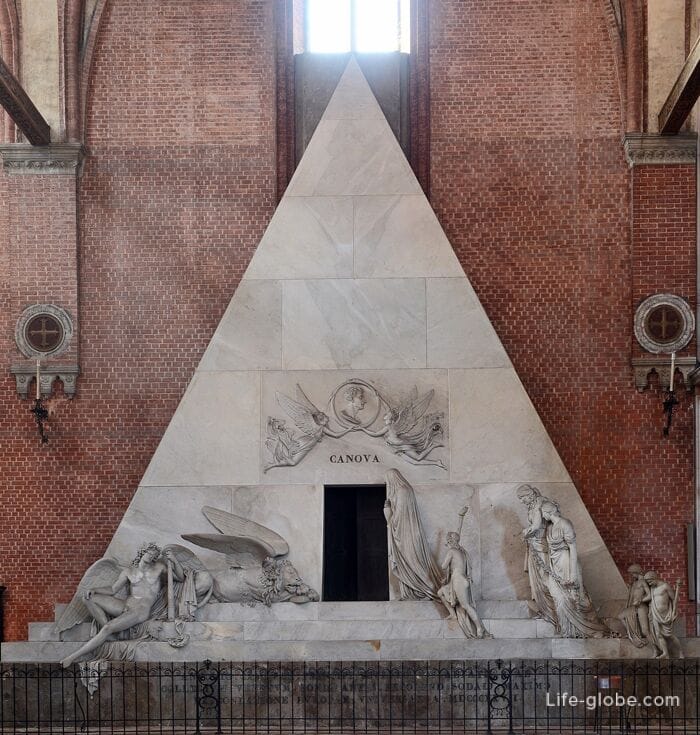
Opposite the tombstone of Canov, in the right aisle of the basilica, there is a monumental marble tombstone to Titian, by Luigi and Pietro Zandomenega 1843-1852.
Titian died in Venice on August 27, 1576. He asked to be buried in this Frari basilica at the foot of that altar of the Crucifixion for which he was preparing his last work, the Pieta, which remained unfinished and was then finished by Palma the Younger.
The monument in the form of a triumphal arch is decorated with allegorical statues and bas-reliefs.
In the center of the monument is dominated by a statue depicting Titian crowned with laurel; next to him is the universal nature and the genius of knowledge with statues of Painting, Sculpture, Graphics and Architecture. Five bas-reliefs remind of the artist's most significant religious works. In the center of his masterpiece is the Assumption; on the left is the Martyrdom of St. Peter of Verona, a magnificent work for the church of Santi Giovanni and Paolo, burned by fire; and on the right is the Martyrdom of St. Lawrence. Above the entablature are carved: on the right - the Visit; and on the left - the Removal from the cross. At the top of the monument stands the lion of St. Mark, holding a shield on which the coat of arms of the Habsburgs is stamped: In memory of the Austrian emperor, surrounded by a wreath supported by two angels; there is an inscription: "TITIANO - FERDINANDUS I - MDCCCLII".
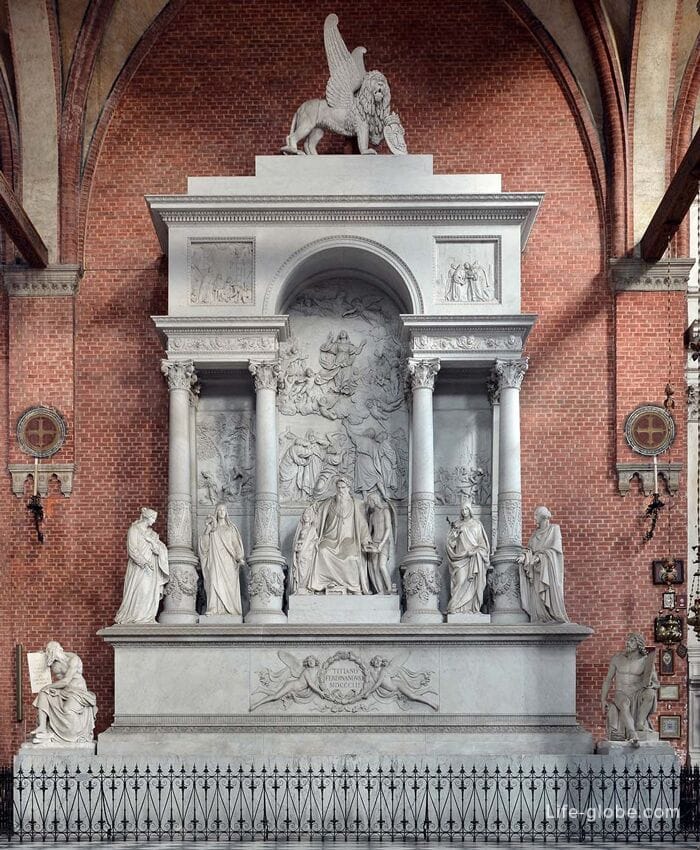
In the extreme left corner of the wall of the right transept, you can see the tombstone of Paolo Savelli, a Roman nobleman in the service of His Serene Highness, who died in 1405.
The hanging urn in Gothic style, decorated with statues of saints and the Madonna and Child and crowned with an equestrian statue of the deceased made of gilded and polychrome wood is the first equestrian statue dedicated to one of the captains of the fate of the republic.
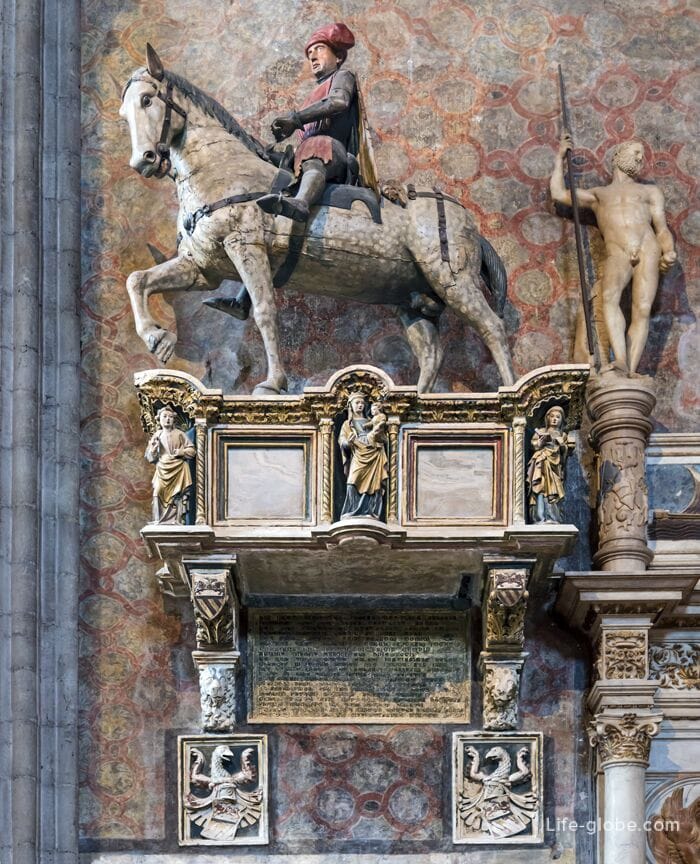
In addition to those listed, there are also other monuments, sculptures and valuable works in the basilica.
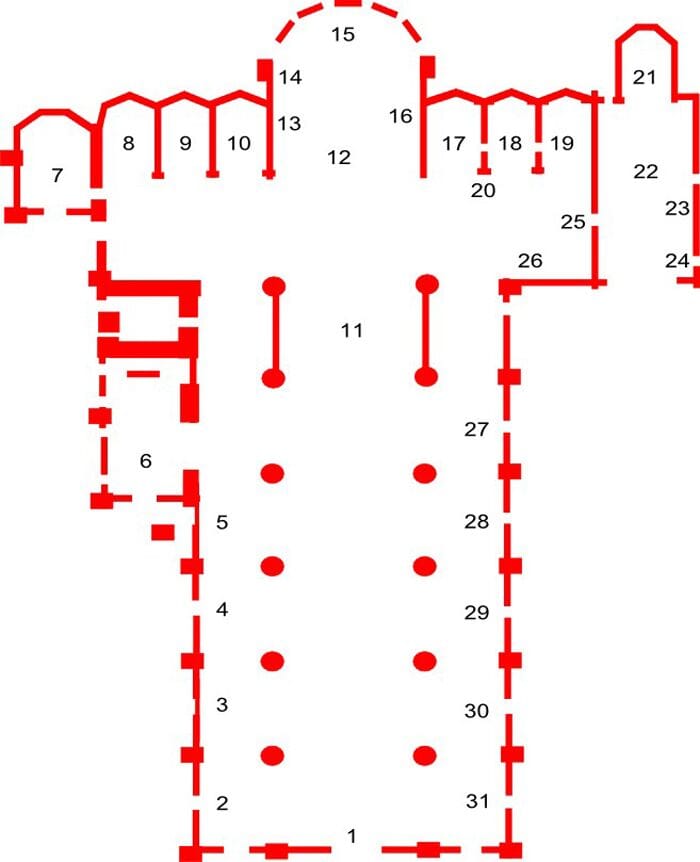
1. Counterfacade
2. Chapel of the Crucifixion
3. Monument to Canova
4. Monument to the Doge of Pesaro
5. Chapel with the Pesaro Madonna by Titian
6. Chapel of San Pietro
7. Chapel of San Marco
8. Milanesi Chapel
9. Chapel of San Michele
10. Chapel of the Franciscan Saints
11. Choir and organ
12. presbytery
13. Monument to the Doge Throne
14. The Crucifixion of the XII century.
15. Assumption of the Virgin, the main altarpiece of Titian (and the main organ)
16. Monument to Doge Foscari
17. Chapel of San Giovanni Battista (St. John the Baptist)
18. Chapel of Father Kolbe (Blessed Sacrament), for personal prayer
19. Bernardo Chapel
20. The Dead Christ
21. Sacristy altar with a triptych by Frari Giovanni Bellini
22. The sacristy
23. Altar of Relics
24. Entrance to the Capitol Hall and the monastery
25. The wall of the right transept
26. Monument to Jacopo Marcello
27. The Altar of St. Catherine
28. Altar of San Giuseppe da Copertino
29. The altar with the representation of Jesus in the temple
30. Monument to Titian
31. Altarpiece of Sant'Antonio da Padua
Entrance to the church is paid. There are discounted tickets. Children under 11 are free.
For a fee, you can take an audio guide. All visitors are provided with a welcome brochure indicating the main monuments of the basilica.
Tickets can be purchased at the main entrance to the basilica.
Concerts are held in the basilica, weddings, baptisms and funerals are also held.
Information about the cost of entrance tickets, opening hours of the basilica, concert schedule, etc., we recommend checking on the official website of the Frari Basilica: basilicadeifrari.it.
The address of the Frari Basilica is: San Polo, 3072, 30125 Venezia VE, Italy.
Coordinates of the Frari Basilica: 45°26'12.0"N 12°19'34.0"E (45.436667, 12.326111).
All accommodation facilities in Venice, including in the historical center of the city and more remotely from it, can be viewed and booked here